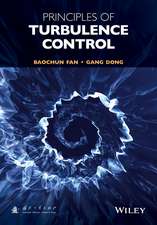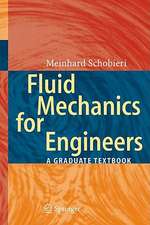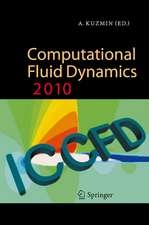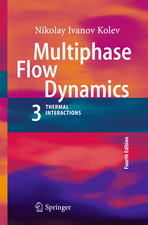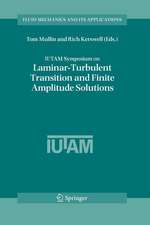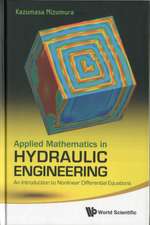IUTAM Symposium on Flow Control and MEMS: Proceedings of the IUTAM Symposium held at the Royal Geographical Society, 19-22 September 2006, hosted by Imperial College, London, England: IUTAM Bookseries, cartea 7
Editat de Jonathan F. Morrison, D. M. Birch, P. Lavoieen Limba Engleză Paperback – 2 ian 2013
Din seria IUTAM Bookseries
- 18%
 Preț: 952.09 lei
Preț: 952.09 lei - 18%
 Preț: 956.99 lei
Preț: 956.99 lei - 15%
 Preț: 648.05 lei
Preț: 648.05 lei - 18%
 Preț: 958.38 lei
Preț: 958.38 lei - 15%
 Preț: 643.84 lei
Preț: 643.84 lei - 18%
 Preț: 955.25 lei
Preț: 955.25 lei - 15%
 Preț: 656.25 lei
Preț: 656.25 lei - 15%
 Preț: 637.28 lei
Preț: 637.28 lei - 15%
 Preț: 640.37 lei
Preț: 640.37 lei - 15%
 Preț: 639.73 lei
Preț: 639.73 lei - 18%
 Preț: 1826.34 lei
Preț: 1826.34 lei - 18%
 Preț: 948.29 lei
Preț: 948.29 lei - 15%
 Preț: 656.43 lei
Preț: 656.43 lei - 18%
 Preț: 967.88 lei
Preț: 967.88 lei - 18%
 Preț: 944.36 lei
Preț: 944.36 lei - 20%
 Preț: 552.13 lei
Preț: 552.13 lei - 24%
 Preț: 1576.18 lei
Preț: 1576.18 lei - 18%
 Preț: 945.62 lei
Preț: 945.62 lei - 18%
 Preț: 1230.35 lei
Preț: 1230.35 lei - 24%
 Preț: 798.22 lei
Preț: 798.22 lei - 24%
 Preț: 799.81 lei
Preț: 799.81 lei - 18%
 Preț: 945.79 lei
Preț: 945.79 lei - 15%
 Preț: 642.83 lei
Preț: 642.83 lei - 18%
 Preț: 950.84 lei
Preț: 950.84 lei - 15%
 Preț: 641.85 lei
Preț: 641.85 lei - 18%
 Preț: 945.79 lei
Preț: 945.79 lei
Preț: 648.89 lei
Preț vechi: 763.40 lei
-15% Nou
Puncte Express: 973
Preț estimativ în valută:
124.18€ • 129.17$ • 102.52£
124.18€ • 129.17$ • 102.52£
Carte tipărită la comandă
Livrare economică 14-28 aprilie
Preluare comenzi: 021 569.72.76
Specificații
ISBN-13: 9789048177400
ISBN-10: 9048177405
Pagini: 472
Ilustrații: XVI, 456 p.
Dimensiuni: 155 x 235 x 25 mm
Greutate: 0.65 kg
Ediția:2008
Editura: SPRINGER NETHERLANDS
Colecția Springer
Seria IUTAM Bookseries
Locul publicării:Dordrecht, Netherlands
ISBN-10: 9048177405
Pagini: 472
Ilustrații: XVI, 456 p.
Dimensiuni: 155 x 235 x 25 mm
Greutate: 0.65 kg
Ediția:2008
Editura: SPRINGER NETHERLANDS
Colecția Springer
Seria IUTAM Bookseries
Locul publicării:Dordrecht, Netherlands
Public țintă
ResearchCuprins
MEMS Devices.- High Power Density MEMS: Materials and Structures Requirements.- MEMS for Flow Control: Technological Facilities and MMMS Alternatives.- MEMS-Based Electrodynamic Synthetic Jet Actuators for Flow Control Applications.- Suction and Oscillatory Blowing Actuator.- Numerical Investigation of a Micro-Valve Pulsed-Jet Actuator.- Characterization of MEMS Pulsed Micro-Jets with Large Nozzles.- Magnetically Actuated Microvalves for Active Flow Control.- Micromachined Shear Stress Sensors for Flow Control Applications.- Synthetic Jets.- Synthetic Jets and Their Applications for Fluid/Thermal Systems.- Is Helmholtz Resonance a Problem for Micro-Jet Actuators?.- Passive Scalar Mixing Downstream of a Synthetic Jet in Crossflow.- Towards a Practical Synthetic Jet Actuator for Industrial Scale Flow Control Applications.- Measurements of Synthetic Jets in a Boundary Layer.- Large-Eddy Simulations of Synthetic Jets in Stagnant Surroundings and Turbulent Cross-Flow.- Characteristics of Small-Scale Synthetic Jets — Numerical Investigation.- Large Eddy Simulations of Transitional and Turbulent Flows in Synthetic Jet Actuators.- Separation Control.- Model Reduction and Control of a Cavity-Driven Separated Boundary Layer.- Collaborative Studies on Flow Separation Control.- High Resolution PIV Study of Zero-Net-Mass-Flow Lift Enhancement of NACA 0015 Airfoil at High Angles of Attack.- Separation Control along a NACA 0015 Airfoil Using a Dielectric Barrier Discharge Actuator.- Dynamic Surface Pressure Based Estimation for Flow Control.- The Control of Laminar Separation Bubbles Using High- and Low-Amplitude Forcing.- Control of Subsonic Flows with High Voltage Discharges.- Control of Flow Separation on a Wing Profile Using PIV Measurements and POD Analysis.- Control of theShear-Layer in the Wake of an Axisymmetrical Airfoil Using a DBD Plasma Actuator.- Drag Reduction and Mixing.- Models for Adaptive Feedforward Control of Turbulence.- Minimum Sustainable Drag for Constant Volume-Flux Pipe Flows.- Enhancement of Suboptimal Controllability in Wall Turbulence.- An Improvement of Opposition Control at High Reynolds Numbers.- Direct Numerical Simulation of Alternated Spanwise Lorentz Forcing.- Boundary Layer Control for Drag Reduction by Lorentz Forcing.- Multi-Scale Flow Control for Efficient Mixing: Laboratory Generation of Unsteady Multi-Scale Flows Controlled by Multi-Scale Electromagnetic Forces.- Multi-Scale Flow Control for Efficient Mixing: Simulation of Electromagnetically Forced Turbulent-Like Laminar Flows.- Closed-Loop Control.- Active Control of Laminar Boundary Layer Disturbances.- Low-Dimensional Tools for Closed-Loop Flow-Control in High Reynolds Number Turbulent Flows.- Evolutionary Optimization of Feedback Controllers for Thermoacoustic Instabilities.- Active Cancellation of Tollmien-Schlichting Instabilities in Compressible Flows Using Closed-Loop Control.- Optimal Boundary Flow Control: Equivalence of Adjoint and Co-State Formulations and Solutions.- Optimal Growth of Linear Perturbations in Low Pressure Turbine Flows.- Simulations of Feedback Control of Early Transition in Poiseuille Flow.- A Switched Reduced-Order Dynamical System for Fluid Flows under Time-Varying Flow Conditions.- Strategies for Optimal Control of Global Modes.- Applications.- Modeling and Development of Synthetic Jet Actuators in Flow Separation Control Application.- Feedback Control Using Extremum Seeking Method for Drag Reduction of a 3D Bluff Body.- Flow Control in Turbomachinery Using Microjets.- ONERA/IEMN Contribution within the ADVACT Program: Actuators Evaluation.- Control of Flow-Induced Vibration of Two Side-by-Side Cylinders Using Micro Actuators.- Improvement of the Jet-Vectoring through the Suppression of a Global Instability.- Passive Control.- Experimental Optimization of Bionic Dimpled Surfaces on Axisymmetric Bluff Bodies for Drag Reduction.- Flow Regularisation and Drag Reduction around Blunt Bodies Using Porous Devices.- The Effects of Aspect Ratio and End Condition on the Control of Free Shear Layers Development and Force Coefficients for Flow Past Four Cylinders in the In-line Square Configuration.- Numerical Simulation on the Control of Drag Force and Vortex Formation by Different Wavy (Varicose) Cylinders.- Passive Multiscale Flow Control by Fractal Grids.- Hydraulic Model of the Skin Friction Reduction with Surface Grooves.- Vortex Shedding behind a Tapered Cylinder and Its Control.- Control of a Separated Flow over a Smoothly Contoured Ramp Using Vortex Generators.- Biomimetic Flight and Flow Control: Learning from the Birds.
Textul de pe ultima copertă
The Symposium brought together many of the world’s experts in fluid mechanics, microfabrication and control theory to discover the synergy that can lead to real advances and perhaps find ways in which collaborative projects may proceed. The meeting website shows the high profile of the meeting (IUTAM sponsorship brings a very considerable cachet: keynote speakers are leaders in their fields; representatives from industry are from companies who have key requirements in flow control — Airbus, BAE SYSTEMS, Rolls Royce, MTU, ONERA, Renault, Peugeot-Citroën — gathered largely from the aerospace and automotive communities. A key driver was the improvement in flow efficiency to reduce drag, and thereby emissions arising from transport. One session was dedicated to industrial representatives offering views on current problems and the identification of appropriate MEMS technology to provide solutions. About 65 papers were presented. Academics from North America, the UK, France, Germany, Switzerland, Spain, Italy, Israel, Australia and China attended.
Caracteristici
Synergy of contributions from three different disciplines, as above





